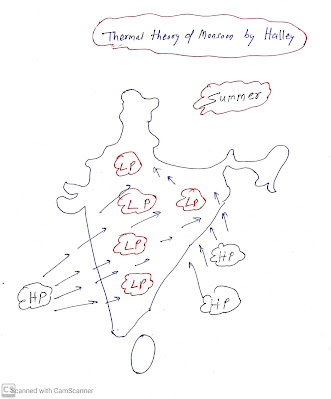Monsoon Thermal Theory by Sir Edmund Hailey:
In 1686, Sir Edmund Halley tried to explain the Monsoon phenomenon based on the classical knowledge of atmospheric circulation. It is also called the extension of land and sea breeze on a larger scale.
As we all know, thermal heating is different on land and water, due to the different heating nature of land and water, pressure differences are created and winds blow from high pressure to low pressure zone.
As per Hailey;
In the Summer;
Sun shines vertically in the tropic of cancer over northern India; low pressure is generated due to thermal heating over India and high pressure is generated over the Indian Ocean, Bay of Bengal, and the Arabian Sea. Winds blow from the ocean with loaded moisture and precipitated on the continents
In the Winter;
There is an opposite situation of Summer atmospheric condition; Sunshine vertically in the Indian ocean and lowe pressure belt is created on the ocean and a high-pressure belt created over Indian continents and winds blow from land to ocean is called winter monsoon.
Limitation of Thermal Theory of Halley:
- Not able to explain the sudden burst of the Indian monsoon.
- Not able to explain the break-in Indian monsoon
- Not able to explain the weak monsoon phenomenon
- It explains the conventional form of rainfall, but monsoonal rainfall is a mix of the convention, orographic, and cyclonic rainfall
- Discuss the major characteristics of the Indian monsoon with special emphasis on the causative factors( UPSC 1922)
- Discuss the recent theories put forward to explain the origin and mechanism of the Indian Monsoon. ( UPSC, 1994)
- Elucidate the mechanism of the Indian Monsoon( UPSC, 1999)
- Explain the Origin, Mechanism, and characteristics of the Summer Monsoon in India. ( UPSC 2002)
- Give a Critical account of the recent theories of the origin of the Indian monsoon with special reference to the Jet Stream Theory. (UPSC, 2006)
- Discuss the mechanism and origin of Monsoon winds and explain the role of El Nino on Monsoon circulation. ( UPSC, 2008)
- Discuss the mechanism of the Indian Monsoon (UPSC 2013)
- Discuss the nature and origin of the Indian monsoon and recent techniques for its prediction. ( UPSC, 2014)
- Give a reasonable account of the Unusual Pattern of Distribution of Monsoonal rainfall in India. ( UPSC, 2017)
- Why is the monsoon erratic in nature? Explain. ( UPSC 2019)
- Explain the origin, progress, and retreat of the Indian monsoon and discuss its impact on the Indian economy. (UPSC 2018, 250 words, 20 marks)
- Elaborate on the origin of monsoon with reference to thermal and recent concepts. ( UPPSC 2020)
- Origin and Mechanism of Indian Monsoon
- Rainfall Pattern of Indian Monsoon
- Jet stream theory of Monsoon
- Characteristics or Nature of Indian monsoon
- Air Mass Theory of Monsoon or ITCZ theory
- Thermal theory of monsoon by Halley
- El Nino | La Nina |SO| ENSO| IOD-Indian Ocean Dipole
- Elaborate on the origin of monsoon with reference to thermal and recent concepts.
- Recent Theory of Origin and Mechanism of Monsoon

ConversionConversion EmoticonEmoticon